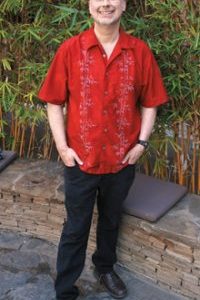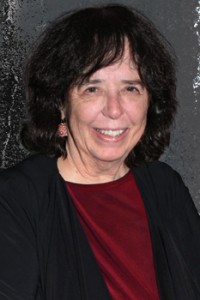Spotlight on Sara A. Mueller
The Bone Orchard is a lush, Gothic-tinged fantasy. Tell us a bit about the book: the world where it takes place, and the characters who inhabit that world.
Charm’s world is ruled by an empire stretched to the brink of collapse, held together by brute force and a single person; and he dies. Boren is trying to hold itself together against the countries it had previously beaten into submission. Its society is manacled to its past by disastrous, necessary decisions. It’s fragile. So much so that even the people society considers harmless can change it. Boreners think Charm is a tame pet, content to be pretty and amusing in her expensive cage. But Orchard House isn’t a cage—it’s Charm’s lair. She’s taken it over and it’s hers from greenhouse to front gate, from root cellar to turret. Her gaudy hair, her revealing bustline, and her extravagant clothes are all camouflage. They’re survival tactics, just as her boneghosts are a survival tactic. One of the longest truths of politics is that politicians tend to let their guard down along with their trousers. There’s no one more aware of that than Charm.
The Bone Orchard is your debut novel. Can you describe your journey from aspiring writer to published author?
Wonderful, frustrating, and amazing. I’d written three trunked novels before I wrote The Bone Orchard—twoso terrible they’ll never see daylight while I live and one that was simply not developed well. It took me ten years to write this book, because I frankly didn’t have the skill to write it when I started. Those ten years were terrific, and fun, and full of amazing, good friends; but I won’t lie—there were some hard, hard days when I wondered why I kept going. I acquired a string of glowing, golden rejections for The Bone Orchard. A lot of people in the industry loved it, but it was too complicated and too prickly to pick up. Friends kept encouraging me, applying metaphorical first aid, and setting me back on my feet. I still loved writing, I still loved telling stories, but the hard days took their toll. I was teetering on the verge of calling it quits when the right courageous people were suddenly there at the right time. Hitting the lottery must feel just about the same. I’m amazed, and humbled, and so very glad that people are picking up my thorny tangle of a book.
Will you return to the world of this book in your future work?
I don’t plan to at this time, but never say never!
Your novel is an unusual mix of necromancy, court politics, sex work, worldbuilding, and even mystery elements. What other works inspired you?
I’m a magpie reader and writer. I’ve picked up tidbits and shiny things from all over. Jo Walton, Ellen Kushner, Robin McKinley, Frank Herbert, Charles de Lint, Chelsea Quinn Yarbro…the list is pretty endless. Pre-20th century influences would include Edith Wharton’s The Custom of the Country, The Way We Live Now, “The Yellow Wallpaper,” Camilla. And Mary Shelley’s Frankenstein, obviously, was a huge influence. For the mystery, I can credit another swathe of writers: John le Carré, Robert Crais, Agatha Christie, Dorothy Sayers, Josephine Tae, and Baroness Orczy’s Lady Molly as well as her Scarlet Pimpernel.
You traveled extensively before settling in the Pacific Northwest, spending time all over the US. Tell us a little about your travels. Did those experiences influence your work?
I think travel always influences us, whether we want it to or not. You get to see how people live, listen to them talk about their problems and their world view. My father’s career bounced us from place to place, not even on a regular basis, and mostly from small town to small town. There are people who’ve moved more than we did, but mostly they’re in the military or in foster care. Sometimes we moved every few years, sometimes we moved for a single summer. The only place we ever went back to was our family cabin on the Keweenaw Peninsula, which is the highest tip of Michigan’s Upper Peninsula, and eventually we were living too far away to go back there. It was a matter of emotional necessity to reference our Irish blood and be, as Kenneth Branagh described in Belfast, “good at leaving.” Though I hadn’t made the connection until just now, Charm is removed from her birth country, and even though she is desperate for her freedom, and even though she remembers where she’s from and misses some things about it, she has no desire to go back. She has made Orchard House her home. She probably gets some of that from me.
You’re an amateur historical costumer and also do historical crafts. What are your areas of interest? Do your different creative outlets feed into each other?
 The Early Modern was the first period that caught me. Crafts throughout that span are an explosion of technologies and cultural interactions that I find enthralling. Things as simple as a frying pan…a better loom…a better plow…they all changed history utterly. The 19th century, with fabulous bustles and stunning tailoring, is such a feast for the eyes that it was completely impossible to resist. My historical creative outlets are a massive, slippery rabbit warren of fiber crafts and food. It’s almost impossible to go deeply into any one area without touching into several more— from sewing to embroidery, to knitting, to natural dyeing, to spinning, and with a scattershot of quilting and a lot of mending along the way. Reenactment led from sewing the costumes into cooking because at the most basic, reenactors have to eat. Washing dishes takes towels, and towels are relatively easy to weave and a great place to practice embroidery before committing it on more expensive cloth. And around and around!
The Early Modern was the first period that caught me. Crafts throughout that span are an explosion of technologies and cultural interactions that I find enthralling. Things as simple as a frying pan…a better loom…a better plow…they all changed history utterly. The 19th century, with fabulous bustles and stunning tailoring, is such a feast for the eyes that it was completely impossible to resist. My historical creative outlets are a massive, slippery rabbit warren of fiber crafts and food. It’s almost impossible to go deeply into any one area without touching into several more— from sewing to embroidery, to knitting, to natural dyeing, to spinning, and with a scattershot of quilting and a lot of mending along the way. Reenactment led from sewing the costumes into cooking because at the most basic, reenactors have to eat. Washing dishes takes towels, and towels are relatively easy to weave and a great place to practice embroidery before committing it on more expensive cloth. And around and around!
Is there anything else you’d like our readers to know? Upcoming work or other projects of note?
I’m currently working on another dark fantasy rife with twisty politics and assassination. It takes its historical inspirations from the Early Modern period instead of 19th century Modern Era. I can’t quite talk about it yet, but I can hardly wait!
SARA A. MUELLER is a debut novelist. She lives in Lake Oswego, OR.









